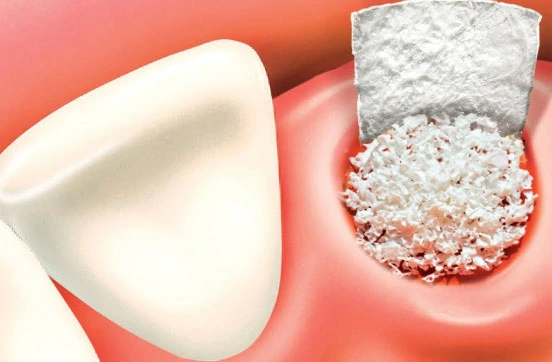As the time passes by, the jawbone in areas of missing teeth either atrophy or get absorbed. Thus, existing bone lessens and dental implants may not have enough room to be placed.

Bone regeneration may correct regions in which we want to place dental implants but there is not enough bone.
This may be due to previous tooth extraction, periodontitis or even after injury.
The bone that will be used for regeneration can be taken from “bone bank grafts” or by the patient himself. In the last case, depending on the quantity we may need, it will be taken from the mandible, lower leg or the end of the ilium (pelvis).
Bone grafts are also placed in the sinus antrum with a technique called “sinus lifting” to increase the bone of the posterior region of the maxilla.
In all cases, bone is placed along with a resorbable membrane that protects the graft during the period that is incorporated in the jaw and then absorbed.
The technique of jaw bones remodeling is called guided bone regeneration and normally takes up to six months to finish.
Widespread jaw bones regeneration is usually performed after accidents in the facial area accompanied by multiple fractures, surgical removal of jaw tumors or surgical correction of congenital abnormalities. In these cases, we use bone from the patient; they are extended operations and are performed in a hospital under general anesthesia.
The maxillary sinuses are behind your cheeks and on top of the upper teeth. Sinuses are like empty rooms that have nothing in them. Some of the roots of the natural upper teeth extend up into the maxillary sinuses. When these upper teeth are removed, there is often just a thin wall of bone separating the maxillary sinus and the mouth. Dental implants need bone to hold them in place. When the sinus wall is very thin, it is impossible to place dental implants in this bone.
There is a solution and it’s called a sinus graft or sinus lift graft. The dental implant surgeon enters the sinus from where the upper teeth used to be. The sinus membrane is then lifted upward and donor bone is inserted into the floor of the sinus. Keep in mind that the floor of the sinus is the roof of the upper jaw. After several months of healing, the bone becomes part of the patient’s jaw and dental implants can be inserted and stabilized in this new sinus bone.
If enough bone between the upper jaw ridge and the bottom of the sinus is available to stabilize the implant well, sinus augmentations and implant placement can sometimes be performed as a single procedure. If not enough bone is available, the Sinus Augmentation will have to be performed first, then the graft will have to mature for several months, depending upon the type of graft material used. Once the graft has matured, the implants can be placed.
Using bone from the patient himself, usually gets better possible results.
There are various areas of the body where bone graft may be derived.
Bone grafts from the maxillofacial region may be taken through the mouth, the wisdom teeth or the upper jaw behind the last tooth.
In more extensive deficits, where a greater quantity of bone graft sites is selected at the ilium (pelvis), and the tibia of the leg.
In many cases we can use allogenic graft with dental implants in areas that need a small amount of bone.
Allogeneic bone derives from banks organ donors and are specially treated so that they can be used to cover bone defects.
When placed in a deficit area promoting osteogenesis to the patient’s bone to grow in the deficit area. Allogenic grafts are transplants very safe and very effective.
They are used either alone or in combination with a bone derived from patient. Synthetic grafts are absorbed largely from the body bio-resolved and excreted usually within 6-8 months.
During this period, the area where placed is retained preventing gums to harsen it, and simultaneously stimulate the body to produce its own bone.
They are gradually replaced by the patient’s bone so that in a given time, they are almost not detected at the original area they were placed.
These type of surgeries, depending on their severity, they are performed either under general or local anesthesia in a hospital.
